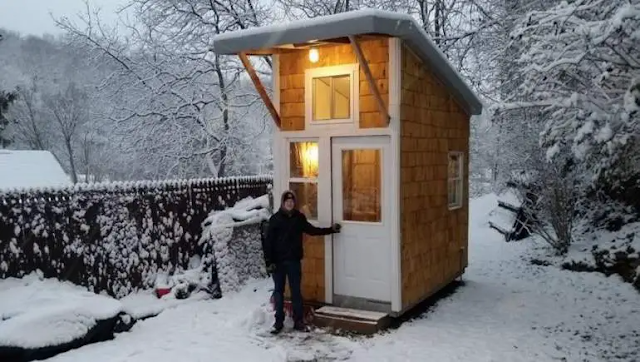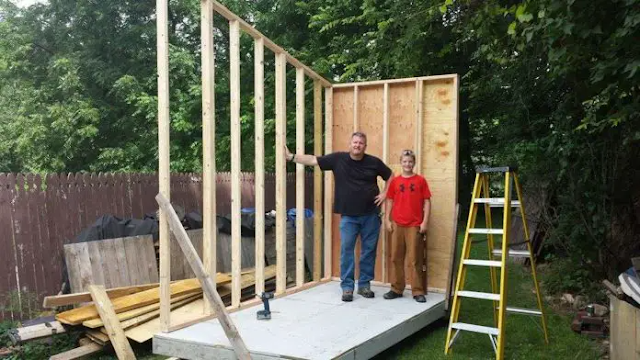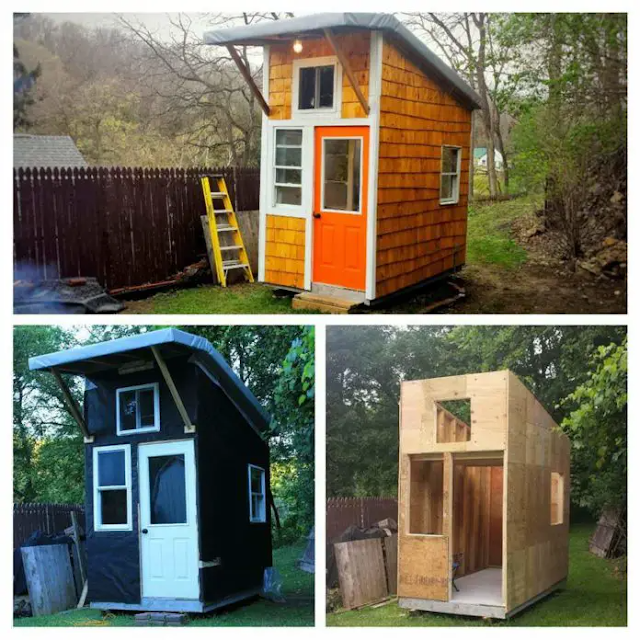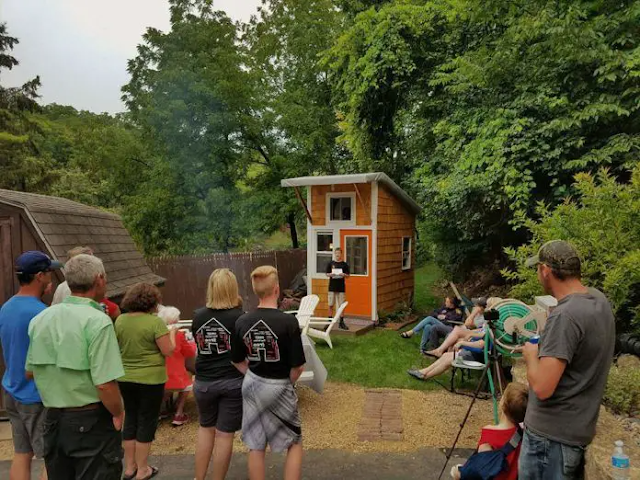At just 13 years old, Luke Thill from Iowa stands out from his peers—not because of his love for video games or gadgets, but because he built his very own tiny house. Unlike most kids his age, Luke turned his boredom into an ambitious project: a fully functional, 89-square-foot house in his parents’ backyard.
A Dream Built on Determination
Luke’s dream of building a house began with a simple desire to do something meaningful. His project, which cost about $1,500, took a year of hard work to complete.

To fund it, Luke mowed lawns, organized online fundraisers, took on odd jobs, and even bartered for services. For instance, a family friend helped him install electrical wiring in exchange for Luke clearing out his garage.

Luke also incorporated sustainability into his project. About 75% of the materials he used were recycled, including items from his grandmother’s house and a front door gifted by his uncle’s friend.
A Minimalist Sanctuary

The tiny house, measuring just 10 feet long and 5.5 feet wide, has electricity but no plumbing yet. Inside, it’s a cozy retreat complete with a loft bed, a microwave, a TV, and even a barbecue setup outside. It’s a space where Luke can unwind, do his homework, and occasionally spend the night.
“I liked the minimalism,” Luke explained. “And I wanted to have a house without a huge mortgage.”

Lessons in Responsibility
Luke’s parents were supportive of his venture but ensured he took ownership of the project. His father, Greg, made sure Luke covered most of the expenses himself.
“It was a chance for a kid to do something more than play video games or sports,” Greg said. “It teaches life lessons.”

Inspiring a Generation
Luke’s story has captured the attention of many, especially through his YouTube channel, where he shares videos documenting his journey. He hopes to inspire other kids to take on big projects and realize their potential.
“I want to show kids it’s possible to build at this age,” Luke said.
Have a look at this project below:
Looking ahead, Luke dreams of building a slightly larger house when he’s older—perhaps one he can use during college.
A Young Visionary
Luke Thill’s tiny house is more than just a personal achievement; it’s a testament to hard work, resourcefulness, and the power of dreaming big. His story is an inspiring example of what young people can accomplish with determination and a little support from their family.
If you’re inspired by Luke’s incredible project, share his story to encourage others to think big and act boldly!
Tentei avisar meu ex-marido sobre sua noiva interesseira, mas ele me ignorou, então tomei uma atitude — História do dia

Meu ex-marido estava pronto para começar um novo capítulo, mas algo sobre seu noivado não me agradou. Uma conversa casual no trabalho se transformou em uma revelação que eu não podia ignorar. Ele se recusou a acreditar em mim, então eu tive que mostrar a verdade a ele — não importa o quanto isso doesse.
Eu estava sentado no trabalho, embora trabalhar como administrador de restaurante não deixasse muito tempo para ficar sentado.

Apenas para fins ilustrativos. | Fonte: Midjourney
Esse foi um daqueles raros momentos em que a área de jantar estava silenciosa: nenhum hóspede pedindo pedidos especiais, nenhuma reclamação da cozinha, nenhum garçom correndo para resolver problemas de última hora.
Respirei fundo, saboreando a paz efêmera, sabendo que ela não duraria.
Meu telefone vibrou no balcão. Olhei para a tela — Aaron. Meu ex-marido. Curiosa, peguei e toquei na mensagem.

Apenas para fins ilustrativos. | Fonte: Midjourney
Uma foto carregada. Era David, nosso filho, sorrindo de orelha a orelha, segurando um bicho de pelúcia gigante. As luzes brilhantes de um parque de diversões brilhavam atrás dele.
Um calor se espalhou por mim. Fiquei feliz que Aaron e David estavam se divertindo.
Perto dali, duas garçonetes conversavam, suas vozes leves e animadas. Lindsey estendeu a mão, seus dedos esticados para exibir um enorme anel de diamante.

Apenas para fins ilustrativos. | Fonte: Midjourney
Claire agarrou a mão de Lindsey, seus olhos arregalados. “Essa pedra é enorme! Provavelmente visível do espaço.”
Lindsey riu, inclinando a mão para pegar a luz. “Eu sei, certo? Eu tive muita sorte.”
Claire levantou uma sobrancelha. “Ele é rico ou algo assim?”
Lindsey sorriu. “Ele não é milionário, mas tem dinheiro. O suficiente para comprar isso, pelo menos.”

Apenas para fins ilustrativos. | Fonte: Midjourney
Franzi o cenho. Lindsey estava namorando Leo, um dos funcionários da nossa cozinha, há mais de um ano. “Você não está com Leo?”, perguntei.
“Eu sou”, disse Lindsey, ainda admirando o anel.
Eu a encarei. “Desde quando Leo é rico?”
Lindsey finalmente olhou para mim. “Leo não é. Mas meu noivo é. Na verdade, foi ideia do Leo.”

Apenas para fins ilustrativos. | Fonte: Midjourney
Eu pisquei. “O quê?”
“O plano era simples”, disse Lindsey. “Encontrar um cara rico, casar com ele, divorciar-se dele em alguns meses, pegar o dinheiro. Então Leo e eu vivemos uma vida boa.” Ela girou o anel em seu dedo. “Está na metade do caminho.”
Meu estômago se revirou. “Você não acha que isso é… cruel?”
Lindsey deu de ombros. “Eu não amo meu noivo, então não.”

Apenas para fins ilustrativos. | Fonte: Midjourney
“Mas ele pode te amar”, eu disse. “Ele me pediu em casamento, não foi?”
Lindsey me dispensou. “Esse é o problema dele. Ele caiu na ideia de que eu sou mais jovem.”
Fiquei olhando para ela, incapaz de acreditar no que estava ouvindo.
Eu me casei jovem e por amor. Naquela época, Aaron e eu acreditávamos que o amor era o suficiente.

Apenas para fins ilustrativos. | Fonte: Midjourney
Mas, com o passar dos anos, percebemos que éramos muito diferentes. Queríamos coisas diferentes, lidávamos com problemas de maneiras opostas e víamos o mundo por lentes separadas.
Deixar ir foi doloroso, mas sabíamos que era a decisão certa. Mesmo agora, eu não tinha arrependimentos.
Aaron ainda era um bom amigo e, mais importante, um pai maravilhoso para David.

Apenas para fins ilustrativos. | Fonte: Midjourney
Naquela noite, quando cheguei em casa, Aaron já estava na porta com David. Meu filho pulou para dentro, seu rosto brilhando de excitação.
“Mãe! Nós fomos na maior montanha-russa! Eu nem fiquei com medo!” ele disse, mal parando para respirar.
Eu sorri, bagunçando seu cabelo. “Parece incrível.”
Aaron, no entanto, estava rigidamente atrás dele. Sua expressão era tensa.

Apenas para fins ilustrativos. | Fonte: Midjourney
“Está tudo bem?”, perguntei.
“Precisamos conversar”, ele disse. “Em particular.”
Eu assenti e o levei para a cozinha.
Nós nos sentamos à mesa. Aaron passou a mão pelos cabelos, seus dedos tamborilando levemente contra a mesa.

Apenas para fins ilustrativos. | Fonte: Midjourney
Algo estava errado. Seus ombros estavam tensos, seu olhar mudando, como se ele não tivesse certeza de como começar.
Eu me inclinei para frente. “Aaron, você está me assustando. Aconteceu alguma coisa?”
Ele exalou bruscamente. “Não, nada ruim. Na verdade… é sério. Mas de um jeito bom.”
Franzi a testa. “Sério no bom sentido? O que você quer dizer?”

Apenas para fins ilustrativos. | Fonte: Midjourney
Aaron hesitou. Então, num suspiro, ele disse: “Vou me casar de novo.”
Pisquei. “O quê? Isso é ótimo!” Sorri, tentando tranquilizá-lo. “Não vejo por que você estava tão preocupado.”
Aaron deu de ombros. “Não sei. Talvez eu tenha pensado que você ficaria chateado.”
“Chateado? Aaron, estou muito feliz por você. Você merece ser feliz.”

Apenas para fins ilustrativos. | Fonte: Midjourney
O alívio suavizou seu rosto. Ele assentiu. “Obrigado. Vou contar ao David depois. Queria que você soubesse primeiro.”
“Claro. Tenho certeza de que ele ficará feliz por você também,” eu disse.
Aaron sorriu, mais relaxado agora.
“Então… quem é ela?”, perguntei. “Você vai me mostrar uma foto? Como vocês dois se conheceram?”

Apenas para fins ilustrativos. | Fonte: Midjourney
Aaron riu. “Eu sabia que você perguntaria.” Ele pegou o telefone e tocou na tela. “Eu vim preparado.”
Ele virou a tela para mim. Meu estômago caiu. Não consegui esconder meu choque.
“Essa é Lindsey,” eu disse, minha voz monótona. “Uma das minhas garçonetes.”
Aaron se mexeu desconfortavelmente. “É. É por isso que eu estava preocupado com sua reação.”

Apenas para fins ilustrativos. | Fonte: Midjourney
Olhei de volta para a foto, minha mente correndo. “Como isso aconteceu?”
Aaron coçou a nuca. “Eu a conheci quando fui buscar David no restaurante. Depois, eu a vi em um aplicativo de namoro. Começamos a conversar… e aqui estamos.”
Engoli em seco. Minhas mãos se fecharam sob a mesa. Não consegui guardar isso para mim.

Apenas para fins ilustrativos. | Fonte: Midjourney
“Aaron, preciso te contar uma coisa,” eu disse cuidadosamente. “E não é nada bom.”
O rosto de Aaron ficou tenso. “Se isso é sobre a diferença de idade, eu já sei. Onze anos. Não nos incomoda.”
Balancei a cabeça. “Não é isso. Hoje mesmo, Lindsey estava falando sobre o noivo dela. Não percebi que ela estava falando de você.”

Apenas para fins ilustrativos. | Fonte: Midjourney
A testa de Aaron franziu. “O que você está dizendo?”
“Ela disse que vai se casar com você só para se divorciar e ficar com seu dinheiro.”
Silêncio. Então, de repente, a expressão de Aaron escureceu. “É exatamente por isso que eu não queria te contar!” ele gritou. “Não acredito que você está inventando isso!”
“Aaron, é a verdade!” protestei. “Por que eu mentiria?”

Apenas para fins ilustrativos. | Fonte: Midjourney
Sua mandíbula se apertou. “Porque você está com ciúmes!”
Eu engasguei. “Com ciúmes? Estou tentando te proteger!”
“Certo. Você simplesmente não consegue suportar que eu tenha encontrado alguém mais jovem que realmente me ama,” Aaron retrucou.
“Ela tem um namorado! Ele trabalha na nossa cozinha!”, gritei.

Apenas para fins ilustrativos. | Fonte: Midjourney
“Você está mentindo!” Seu rosto estava vermelho de raiva. “Não acredito que você caiu tão baixo.”
“É a verdade!”
“Essa conversa acabou.” Ele saiu furioso, batendo a porta da frente atrás de si.
Eu não podia deixar isso passar. Eu não permitiria que Lindsey enganasse Aaron. Ele não merecia isso. Não importava o quão bravo ele estivesse comigo, eu tinha que fazê-lo ver a verdade.

Apenas para fins ilustrativos. | Fonte: Midjourney
A noite toda, fiquei pensando nisso. Aaron não acreditaria somente em palavras — ele precisava de provas. Provas claras e inegáveis.
No dia seguinte, fiquei de olho em Leo. Ele estava trabalhando na cozinha, focado em cortar vegetais. Respirei fundo e fui até lá.
“Ei, Leo”, eu disse, me aproximando. “Você e Lindsey formam um casal tão legal. Eu estava pensando — por que não surpreendê-la com um jantar romântico aqui depois do fechamento? Ela adoraria.”

Apenas para fins ilustrativos. | Fonte: Midjourney
O rosto de Leo se iluminou. “Você realmente acha isso?”
“Absolutamente”, eu disse. “Ela até mencionou querer algo especial assim recentemente.”
Ele limpou as mãos no avental, parecendo animado. “Uau, eu não tinha ideia. Isso parece perfeito.”

Apenas para fins ilustrativos. | Fonte: Midjourney
Eu concordei. “Você poderia arrumar uma mesa bonita, talvez trazer algumas flores. Ela adoraria o esforço.”
Leo sorriu. “Essa é uma ótima ideia, Melanie. Obrigado por sugerir. Posso fazer isso hoje à noite?”
Eu sorri. “Claro.”

Apenas para fins ilustrativos. | Fonte: Midjourney
Depois disso, enviei uma mensagem para Aaron. Minhas mãos pairaram sobre o teclado por um momento antes de eu digitar.
Eu sabia que ele não responderia. Ele estava muito bravo. Mas ele não precisava responder — ele só precisava ler.
@Meu
Eu sei que você acha que estou mentindo, mas se você quer a verdade, venha ao restaurante depois das 22h.

Apenas para fins ilustrativos. | Fonte: Midjourney
Apertei enviar e exalei. Meu peito estava apertado. Ele viria? Ele me ignoraria? Eu não tinha como saber. Tudo o que eu podia fazer era esperar.
Naquela noite, depois de colocar David para dormir, abri meu laptop. Meus dedos tremeram levemente enquanto eu fazia login no sistema de segurança do restaurante.
As câmeras piscaram e ganharam vida. Encontrei o ângulo certo — um que mostrava a mesa que Leo tinha montado.

Apenas para fins ilustrativos. | Fonte: Midjourney
Velas tremeluziam na luz fraca. Um pequeno vaso com flores estava no centro. Parecia romântico. Romântico demais.
Observei Leo e Lindsey sentados juntos. Eles comeram, conversaram e riram. Os olhos de Leo brilharam de amor.
Ele era completamente devotado a ela. Lindsey sorriu, enrolando uma mecha de cabelo em volta do dedo.

Apenas para fins ilustrativos. | Fonte: Midjourney
Ela se inclinou, roçando a mão no braço dele. Então, finalmente, ela o beijou.
Fiz uma careta e troquei de câmera rapidamente. Não consegui assistir aquilo. Meu estômago se revirou.
Na câmera externa, um movimento chamou minha atenção. Minha respiração ficou presa. Aaron estava lá. Ele tinha vindo. Ele abriu a porta do restaurante e entrou.

Apenas para fins ilustrativos. | Fonte: Midjourney
Coração batendo forte, voltei para Lindsey e Leo. Bem na hora.
Aaron apareceu, seu rosto contorcido de raiva. Lindsey e Leo se separaram, suas expressões mudando de choque para pânico.
A boca de Leo se abriu, mas nenhuma palavra saiu. Os olhos de Lindsey dispararam ao redor, procurando uma saída.

Apenas para fins ilustrativos. | Fonte: Midjourney
A voz de Aaron retumbou. Não consegui ouvir o que ele disse, mas sua raiva era clara. Ele apontou para Lindsey, depois para Leo.
Lindsey cruzou os braços, jogando o cabelo por cima do ombro, mas Leo parecia aterrorizado.
Então, de repente, Lindsey arrancou seu anel de noivado e jogou em Aaron.

Apenas para fins ilustrativos. | Fonte: Midjourney
Ele caiu ruidosamente na mesa. Aaron o pegou, seu rosto pálido. Sem outra palavra, ele se virou e saiu furioso.
Troquei de câmera novamente. Lá fora, Aaron estava parado, seus ombros tremendo.
Sua cabeça caiu em sua mão. Mesmo de trás de uma tela, eu podia dizer—ele estava chorando.

Apenas para fins ilustrativos. | Fonte: Midjourney
Engoli em seco. Eu tinha feito a coisa certa. Ele precisava ver a verdade. Mas, de alguma forma, eu ainda me sentia culpada.
Depois de um tempo, a campainha tocou. Hesitei antes de abrir. Aaron estava ali, com o rosto vermelho de tanto chorar, os olhos cheios de arrependimento.
“Você estava certo”, ele disse, com a voz rouca.

Apenas para fins ilustrativos. | Fonte: Midjourney
“Isso não é satisfatório para mim, só para você saber”, eu disse. “Eu não queria estar certo sobre isso.”
Aaron assentiu, seus ombros pesados. “Sinto muito por duvidar de você.” Ele respirou fundo. “Eu deveria ter confiado em você.”
Ele deu um passo à frente e me puxou para um abraço. “Obrigado.”
Eu o abracei de volta, sentindo sua dor.

Apenas para fins ilustrativos. | Fonte: Midjourney



Leave a Reply